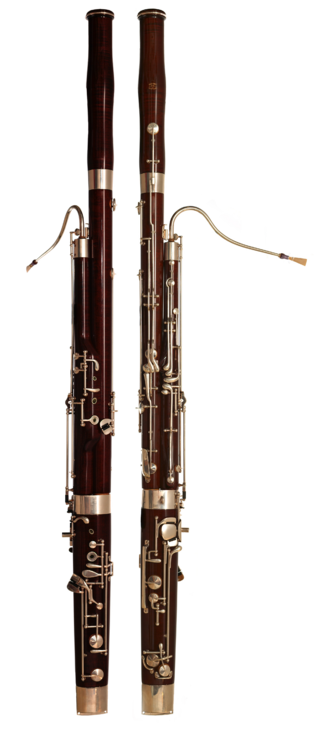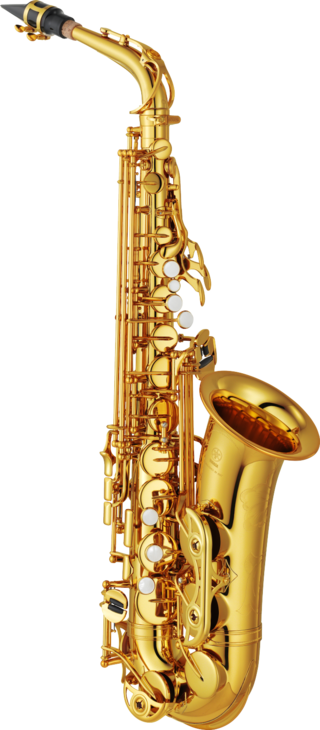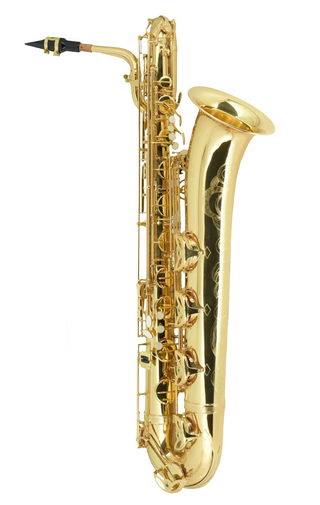Related Research Articles

The bassoon is a musical instrument in the woodwind family, which plays in the tenor and bass ranges. It is composed of six pieces, and is usually made of wood. It is known for its distinctive tone color, wide range, versatility, and virtuosity. It is a non-transposing instrument and typically its music is written in the bass and tenor clefs, and sometimes in the treble. There are two forms of modern bassoon: the Buffet and Heckel systems. It is typically played while sitting using a seat strap, but can be played while standing if the player has a harness to hold the instrument. Sound is produced by rolling both lips over the reed and blowing direct air pressure to cause the reed to vibrate. Its fingering system can be quite complex when compared to those of other instruments. Appearing in its modern form in the 19th century, the bassoon figures prominently in orchestral, concert band, and chamber music literature, and is occasionally heard in pop, rock, and jazz settings as well. One who plays a bassoon is called a bassoonist.

A brass instrument is a musical instrument that produces sound by sympathetic vibration of air in a tubular resonator in sympathy with the vibration of the player's lips. Brass instruments are also called labrosones or labrophones, from Latin and Greek elements meaning 'lip' and 'sound'.

A musical keyboard is the set of adjacent depressible levers or keys on a musical instrument. Keyboards typically contain keys for playing the twelve notes of the Western musical scale, with a combination of larger, longer keys and smaller, shorter keys that repeats at the interval of an octave. Pressing a key on the keyboard makes the instrument produce sounds—either by mechanically striking a string or tine, plucking a string (harpsichord), causing air to flow through a pipe organ, striking a bell (carillon), or activating an electronic circuit. Since the most commonly encountered keyboard instrument is the piano, the keyboard layout is often referred to as the piano keyboard or simply piano keys.

The saxophone is a type of single-reed woodwind instrument with a conical body, usually made of brass. As with all single-reed instruments, sound is produced when a reed on a mouthpiece vibrates to produce a sound wave inside the instrument's body. The pitch is controlled by opening and closing holes in the body to change the effective length of the tube. The holes are closed by leather pads attached to keys operated by the player. Saxophones are made in various sizes and are almost always treated as transposing instruments. A person who plays the saxophone is called a saxophonist or saxist.

The sarrusophones are a family of metal double reed conical bore woodwind instruments patented and first manufactured by French instrument maker Pierre-Louis Gautrot in 1856. Gautrot named the sarrusophone after French bandmaster Pierre-Auguste Sarrus (1813–1876), whom he credited with the concept of the instrument, though it is not clear whether Sarrus benefited financially. The instruments were intended for military bands, to serve as replacements for oboes and bassoons which at the time lacked the carrying power required for outdoor marching music. Although originally designed as double-reed instruments, single-reed mouthpieces were later developed for use with the larger bass and contrabass sarrusophones.

The alto saxophone is a member of the saxophone family of woodwind instruments. Saxophones were invented by Belgian instrument designer Adolphe Sax in the 1840s and patented in 1846. The alto saxophone is pitched in the key of E♭, smaller than the B♭ tenor but larger than the B♭ soprano. It is the most common saxophone and is used in popular music, concert bands, chamber music, solo repertoire, military bands, marching bands, pep bands, carnatic music, and jazz.

The baritone saxophone is a member of the saxophone family of instruments, larger than the tenor saxophone, but smaller than the bass. It is the lowest-pitched saxophone in common use - the bass, contrabass and subcontrabass saxophones are relatively uncommon. Like all saxophones, it is a single-reed instrument. It is commonly used in concert bands, chamber music, military bands, big bands, and jazz combos. It can also be found in other ensembles such as rock bands and marching bands. Modern baritone saxophones are pitched in E♭.
The soprano saxophone is a higher-register variety of the saxophone, a woodwind instrument invented in the 1840s. The soprano is the third-smallest member of the saxophone family, which consists of the sopranissimo, sopranino, soprano, alto, tenor, baritone, bass, contrabass saxophone. Soprano saxophones are the smallest and thus highest-pitched saxophone in common use.
C. G. Conn Ltd., Conn Instruments or commonly just Conn, is a former American manufacturer of musical instruments incorporated in 1915. It bought the production facilities owned by Charles Gerard Conn, a major figure in early manufacture of brasswinds and saxophones in the USA. Its early business was based primarily on brass instruments, which were manufactured in Elkhart, Indiana. During the 1950s the bulk of its sales revenue shifted to electric organs. In 1969 the company was sold in bankruptcy to the Crowell-Collier-MacMillan publishing company. Conn was divested of its Elkhart production facilities in 1970, leaving remaining production in satellite facilities and contractor sources.
The Western concert flute is a family of transverse (side-blown) woodwind instruments made of metal or wood. It is the most common variant of the flute. A musician who plays the flute is called a “flautist” in British English, a “flutist” in American English.

Henri Selmer Paris is a French enterprise, manufacturer of musical instruments based at Mantes-la-Ville near Paris. Founded in 1885, it is known as a producer of professional-grade woodwind and brass instruments, especially saxophones, clarinets and trumpets. Henri Selmer Paris used to be family-owned but was sold to Argos-Wityu in 2018.

Holton is a brand owned by the Conn-Selmer division of Steinway Musical Instruments. The original business was a used instrument shop began in 1898 by American trombone player Frank Holton in Chicago, Illinois. The firm built brass instruments for ten years in Chicago, then in Elkhorn, Wisconsin from 1918 until 2008, when production of Holton-branded instruments moved to Eastlake, Ohio. The business remained independent until it was acquired by Leblanc in 1964. Leblanc was acquired by Conn-Selmer in 2004 and its properties became subsidiaries of Conn-Selmer.
The Buescher Band Instrument Company was a manufacturer of musical instruments in Elkhart, Indiana, from 1894 to 1963. The company was acquired by the H&A Selmer Company in 1963. Selmer retired the Buescher brand in 1983.

The Martin Band Instrument Company was a musical instrument manufacturer in Elkhart, Indiana. The firm produced band instruments, including trumpets, cornets, fluegelhorns, trombones, and saxophones from 1908 through the 1960s. The brand was acquired by the Leblanc Corporation in 1971 and discontinued in 2007 after Leblanc's 2004 acquisition by Conn-Selmer.
Leblanc, Inc. was a musical instruments manufacturing company based in Kenosha, Wisconsin. The company was a woodwind instrument manufacturer known mainly for its clarinets. In 2004 the firm was sold to Conn-Selmer, a division of Steinway Musical Instruments. As a result, Leblanc ceased to exist as an independent operation, becoming a brand.

The Firebird is a type of trumpet with the standard three valves and the addition of a trombone-style slide. It was invented by Maynard Ferguson and Larry Ramirez and remains an exceptionally rare, specialist instrument. They were occasionally produced by Holton.
The Mazzeo system is a key system for the clarinet invented by Rosario Mazzeo in the 1950s, and is a modification of the Boehm system. Exclusive mass-production rights were given to the Selmer company, although only 13,000 were made.

The Selmer Mark VI is a saxophone produced from 1954 to 1981. Production shifted to the Mark VII for the tenor and alto in the mid-1970s, and to the Super Action 80 for the soprano and baritone saxophones in 1981. The sopranino saw limited production until about 1985.

King Musical Instruments is a former musical instrument manufacturing company located in Cleveland, Ohio, that used the trade name King for its instruments. In 1965 the company was acquired by the Seeburg Corporation of Eastlake, Ohio, and the name changed to "King Musical Instruments".

Backun Musical Services Ltd. (BMS) is a Canadian manufacturer of clarinets in B♭ and A and accessories, based in Burnaby, British Columbia.
References
- ↑ "Home | National Music Museum | Vermillion".
- ↑ "F. E. Olds and Son Serial Numbers".
- ↑ "The Selmer Balance Action :: SaxPics.com". The Vintage Saxaphone Gallery presented by USA Horn. Archived from the original on 2008-12-30.
- ↑ "L'Histoire des saxophones de légende".
{{cite web}}: CS1 maint: url-status (link) - ↑ "Conn 6M alto key table". saxpics.com. Retrieved 8 April 2019.
- ↑ "Conn 26M alto key table". saxpics.com. Retrieved 8 April 2019.